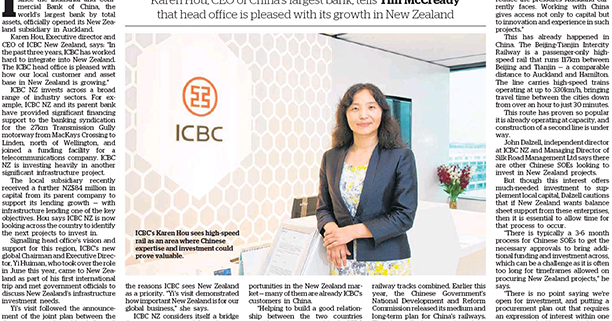Infrastructure: ICBC on lookout for projects (NZ Herald)
Tim McCready
It has been almost three years since the Industrial and Commercial Bank of China, the world’s largest bank by total assets, officially opened its New Zealand subsidiary in Auckland.
Karen Hou, executive director and CEO of ICBC New Zealand, says: “In the past three years, ICBC has worked hard to integrate into New Zealand. The ICBC head office is pleased with how our local customer and asset base in New Zealand is growing.”
ICBC NZ invests across a broad range of industry sectors. For example, ICBC NZ and its parent bank have provided significant financing support to the banking syndication for the 27km Transmission Gully motorway from MacKays to Linden and joined a funding facility for a telecommunications company. ICBC NZ is also investing heavily in another significant infrastructure project.
The local subsidiary recently received a further NZ$84 million in capital from its parent company to support its lending growth with infrastructure lending one of the key objectives. Hou says ICBC NZ is now looking across the country to identify the next projects to invest in.
Signalling head office’s vision and support for this region, ICBC’s new global chairman and executive director, Yi Huiman, who took over the role in June this year, came to New Zealand as part of his first international trip. While here, he met with government officials to discuss New Zealand’s infrastructure investment needs.
Yi’s visit followed the announcement of the joint plan between the Government and Auckland Council for Auckland’s transport priorities over the next 30 years, including motorway upgrades, new busways and upgrades to the rail network.
Outside of Auckland, big projects include Wellington’s Transmission Gully Motorway, Tauranga’s Northern Link road and several key pieces of infrastructure in the Christchurch rebuild.
Hou says that the clear strategy outlined by the New Zealand Government and Auckland Council on future infrastructure programmes is one of the reasons ICBC sees New Zealand as a priority.
“Yi’s visit demonstrated how important New Zealand is for our global business,” she says.
ICBC NZ considers itself a bridge that can encourage bilateral trade and economic co-operation. The bank’s experience with infrastructure projects across many countries means that it has the ability to add value beyond funding.
“We also bring experience and expertise across a range of infrastructure classes, such as bridges, railways, motorways, schools, power and water.
“There are very big Chinese companies, operating at very high international standards, that are increasingly interested in investment opportunities in the New Zealand market. Many of them are already ICBC’s customers in China.
“Helping to build a good relationship between the two countries provides great opportunities for ICBC NZ. We can help investors understand the market and how to be successful here,” Hou says.
Hou’s personal vision for Auckland is one where the city is well connected to other regional hubs, pointing to China’s strength in high-speed rail as an opportunity that could be leveraged here.
China leads the world in high-speed rail technology, with over 20,000km of tracks in service – a length that is more than the rest of the world’s high-speed railway tracks combined.
Earlier this year, the Chinese Government’s National Development & Reform Commission released their medium and long-term plan for China’s railways. The plan calls for expansion of the high-speed railway network by 2025 to 38,000km of passenger-dedicated lines. The volume of work means China is driving innovation in infrastructure development globally.
“Auckland is becoming increasingly concentrated, bringing with it a rapid growth in house prices and significant traffic congestion,” says Hou.
“Suppose there was a high-speed train between Auckland and Hamilton. A 30-minute commute between the two cities would encourage people to spread to the regions, and reduce the pressures Auckland currently faces. Working with China gives access not only to capital but access to innovation and experience in such projects.”
This has already happened in China. The Beijing Tianjin Intercity Railway is a passenger-only high-speed rail that runs 117km between Beijing and Tianjin – a comparable distance to Auckland and Hamilton. The line carries high-speed trains operating at up to 330km/h, bringing the travel time between the cities down from over an hour to just 30 minutes.
This route has proven so popular that it is already operating at capacity, and construction of a second line is under way.
John Dalzell, independent director at ICBC NZ and managing director of Silk Road Management Ltd, says that there are other Chinese SOEs looking to invest in New Zealand projects.
But while this interest offers much needed investment to supplement local capital, Dalzell cautions that if New Zealand wants balance sheet support from these enterprises, then it is essential to allow time for that process to occur.
“There is typically a 3-6 month process for Chinese SOEs to get the necessary approvals to bring additional funding and investment across, which can be a challenge as it is often too long for timeframes allowed on procuring New Zealand projects,” he says.
“There is no point saying we’re open for investment and putting a procurement plan out that requires an expression of interest within one or two months if we are looking to attract firms with this type of financial capacity to our projects.”
Hou reiterates the importance of New Zealand as a partner to China. “The interconnectivity of “One Belt and One Road” and the Asia-Pacific means that ICBC is likely to further increase financial support for the New Zealand market.
“New Zealand is one end of an important economic corridor, stretching from the South Pacific through Southeast Asia and into Europe.”




Leave a Reply
Want to join the discussion?Feel free to contribute!